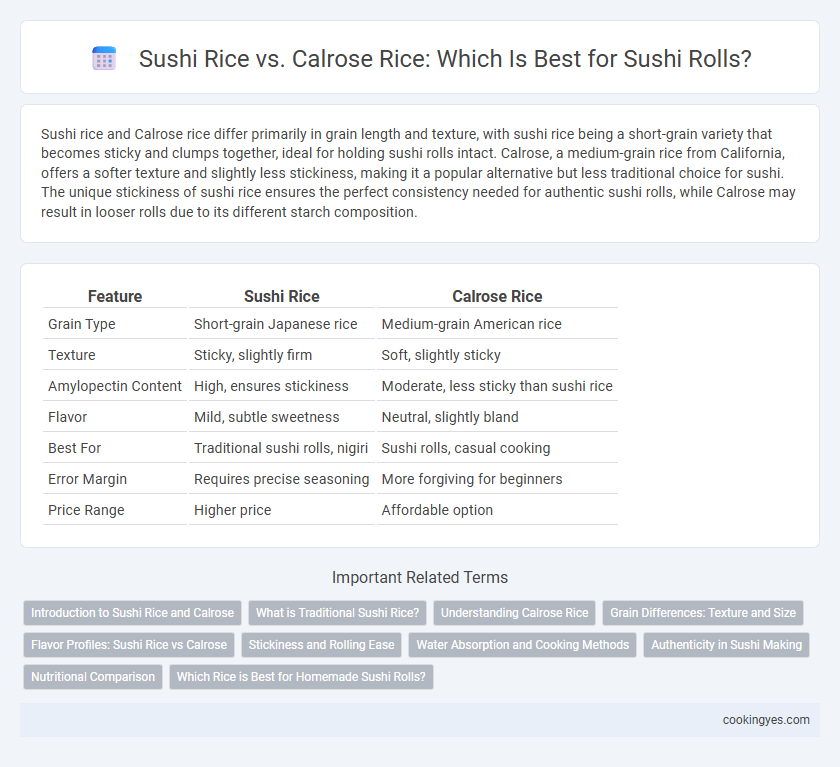Sushi rice and Calrose rice differ primarily in grain length and texture, with sushi rice being a short-grain variety that becomes sticky and clumps together, ideal for holding sushi rolls intact. Calrose, a medium-grain rice from California, offers a softer texture and slightly less stickiness, making it a popular alternative but less traditional choice for sushi. The unique stickiness of sushi rice ensures the perfect consistency needed for authentic sushi rolls, while Calrose may result in looser rolls due to its different starch composition.
Table of Comparison
| Feature | Sushi Rice | Calrose Rice |
|---|---|---|
| Grain Type | Short-grain Japanese rice | Medium-grain American rice |
| Texture | Sticky, slightly firm | Soft, slightly sticky |
| Amylopectin Content | High, ensures stickiness | Moderate, less sticky than sushi rice |
| Flavor | Mild, subtle sweetness | Neutral, slightly bland |
| Best For | Traditional sushi rolls, nigiri | Sushi rolls, casual cooking |
| Error Margin | Requires precise seasoning | More forgiving for beginners |
| Price Range | Higher price | Affordable option |
Introduction to Sushi Rice and Calrose
Sushi rice, also known as japonica rice, is a short-grain variety prized for its sticky texture and ability to absorb flavors, essential for authentic sushi rolls. Calrose rice, a medium-grain variety developed in California, offers a slightly softer and less sticky texture compared to traditional sushi rice, making it a popular alternative in Western sushi preparations. Both types provide the necessary moisture and adhesion to hold sushi rolls together while complementing the delicate flavors of fish and vegetables.
What is Traditional Sushi Rice?
Traditional sushi rice is short-grain Japonica rice, prized for its sticky texture and ability to absorb the distinctive sushi vinegar seasoning. Unlike Calrose, a medium-grain rice developed in California with a softer, less sticky consistency, authentic sushi rice ensures that sushi rolls hold together firmly and deliver the ideal balance of chewiness and moisture. The precise starch composition and polishing process of traditional sushi rice are key factors that contribute to its essential role in classic sushi preparation.
Understanding Calrose Rice
Calrose rice, a medium-grain variety developed in California, is prized for its slightly sticky texture and mild flavor, making it an excellent choice for sushi rolls. Compared to traditional Japanese sushi rice, Calrose absorbs water well and holds together without becoming overly gummy, enhancing the roll's structural integrity. Its versatility and availability have made Calrose a popular alternative for home cooks and chefs seeking quality sushi rice outside Japan.
Grain Differences: Texture and Size
Sushi rice features short, plump grains with a sticky texture essential for holding sushi rolls together, while Calrose rice has medium-grain size with a slightly less sticky, softer texture. The stickiness of sushi rice is due to its higher amylopectin content, which ensures the rolls maintain their shape and texture. Calrose, often used as a substitute, provides a chewier bite but lacks the precise adhesion characteristics critical for traditional sushi preparation.
Flavor Profiles: Sushi Rice vs Calrose
Sushi rice offers a slightly sticky texture with a clean, subtly sweet flavor that enhances the delicate taste of raw fish in sushi rolls. Calrose rice, while also sticky, has a softer texture and a more neutral flavor profile, making it a versatile but less traditional choice for sushi. The distinct aromatic qualities and firmness of sushi rice provide a more authentic and satisfying sushi experience compared to the milder taste of Calrose.
Stickiness and Rolling Ease
Sushi rice, typically short-grain Japonica rice, exhibits higher stickiness compared to Calrose rice, enabling easier shaping and firm rolling in sushi preparation. Calrose rice, a medium-grain variety, offers moderate stickiness but may result in looser rolls prone to falling apart. For optimal rolling ease and authentic texture, sushi chefs prefer the superior adhesive quality of traditional sushi rice over Calrose.
Water Absorption and Cooking Methods
Sushi rice absorbs water differently compared to Calrose rice, with sushi rice typically requiring slightly less water due to its shorter grain and higher starch content, which results in a stickier texture ideal for sushi rolls. Cooking methods for sushi rice emphasize rinsing thoroughly to remove excess starch and using a precise water-to-rice ratio, often around 1:1.2, to achieve the perfect balance of moisture and stickiness. Calrose rice, with its medium grain and moderate absorbency, offers a slightly softer texture and is more forgiving during cooking, accommodating a water ratio near 1:1.5 for sushi preparation.
Authenticity in Sushi Making
Sushi rice, traditionally short-grain Japonica rice, is essential for authentic sushi rolls due to its sticky texture and ability to absorb seasoning evenly. Calrose rice, a medium-grain variety developed in California, offers a softer texture and slightly less stickiness, making it a popular alternative yet less authentic choice in traditional sushi preparation. The unique properties of authentic sushi rice, including its higher amylopectin content, contribute to the precise texture and flavor balance crucial for genuine sushi craftsmanship.
Nutritional Comparison
Sushi rice and Calrose rice have similar carbohydrate content, but sushi rice typically contains slightly more protein, enhancing its nutritional profile for sushi rolls. Calrose rice absorbs water differently, affecting texture but maintaining comparable levels of fiber and essential minerals like magnesium and phosphorus. Both options offer low fat and modest calorie counts, making them suitable for balanced sushi meals.
Which Rice is Best for Homemade Sushi Rolls?
Sushi rice, typically short-grain Japonica rice, is best for homemade sushi rolls due to its ideal stickiness and slightly sweet flavor that helps the rolls hold together firmly. Calrose rice, a medium-grain variety developed in California, offers a softer texture and moderate stickiness, making it a popular and accessible alternative but less authentic than true sushi rice. For perfect sushi rolls, sushi rice enhances flavor and texture, while Calrose provides a budget-friendly option with slightly less optimal binding qualities.
Sushi Rice vs Calrose for Sushi Rolls Infographic

 cookingyes.com
cookingyes.com